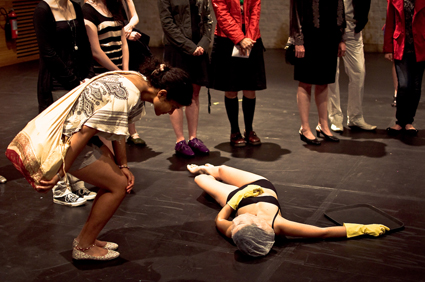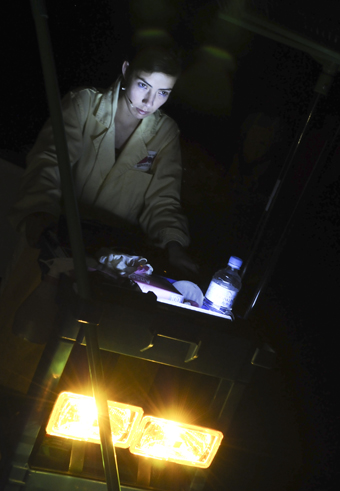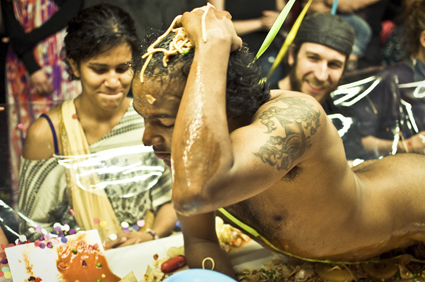March 29 2011
sounds massive
gail priest: the soundtracks of dance massive
the limits of the extraordinary
nilsson-polias: force majeure, not in a million years, dance massive
March 27 2011
let's dance—and we do
jana perkovic: bluemouth inc, dance marathon, dance massive
the unexploited
keith gallasch: antony hamilton, drift, dance massive
March 26 2011
post-apocalyptic drive-in dancing
carl nilsson-polias: antony hamilton, drift, dance massive
suspending self, time & disbelief
keith gallasch, virginia baxter: trevor patrick, i could pretend the sky is water, dance massive
talkin' 'bout my generation
philipa rothfield: becky, jodi & john, john jasperse company, dance massive
the truth of the matter, or not
jana perkovic: gideon obarzanek, faker, chunky move dance massive
March 24 2011
erupting from the archive
carl nilsson-polias: balletlab, amplification, dance massive
realtime video interview: trevor patrick
i could pretend the sky is water
March 23 2011
in the heat of the moment
keith gallasch: deanne butterworth, matthew day, dance massive
the ambiguities of happiness
jana perkovic: shaun parker, happy as larry, dance massive
March 22 2011
displacements: space, stage, workplace
keith gallasch: branch nebula's sweat & other works
present, tense
virginia baxter: luke george, now now now: dance massive
realtime video interview: luke george
now now now
March 20 2011
realtime video interview: gideon obarzanek
connected
realtime video interview: madeleine flynn & tim humphrey
music for imagined dances
realtime video interview: michelle heaven & brian lucas
disagreeable object
realtime video interview: rosalind crisp
no one will tell us...
March 19 2011
the poisoned pea
virginia baxter: michelle heaven, disagreeable object, dance massive
turning the tables, working the audience
carl nilsson-polias: sweat, branch nebula, dance massive
March 18 2011
dance like never before
keith gallasch: rosalind crisp, no one will tell us...; dance massive
the uneasy weight of metaphor
virginia baxter: shaun mcleod, the weight of the thing left its mark
March 17 2011
into the dance-scape
jana perkovic: narelle benjamin, in glass, dance massive
kinetics: sculpted & danced
carl nilsson-polias: connected, chunky move, dance massive
the art machine dances
keith gallasch: connected, chunky move, dance massive
March 16 2011
ghost dancing
keith gallasch: narelle benjamin, in glass, dance massive
journey of the tribe
jana perkovic: herbertson & cobham, sunstruck, dance massive
March 10 2011
kinetic art machine makes waves for dance
john bailey: reuben margolin & chunky move's connected
February 21 2011
dance massive 2011 artists: from the archive
force majeure, not in a million years; narelle benjamin, in glass, chunky move, faker; branch nebula, sweat; shaun mcleod, the weight of the thing left its mark: luke george, now, now, now; phillip adams amplification
the meeting point
sophie travers: steven richardson, dance massive
 |
Claudia Escobar, Sweat, Branch Nebula
photo Heidrun Löhr |
BRANCH NEBULA’S SWEAT IS CONCERNED WITH TURNING OUR ATTENTION TO THE INVISIBLE MEMBERS OF SOCIETY—THE ONES WHO PULL BACK OUR CHAIRS, SWEEP UP OUR DEAD SKIN, WIPE AWAY OUR SKIDMARKS AND COLLECT OUR CAFETERIA TRAYS. COINCIDENTALLY, CHUNKY MOVE’S CONNECTED TOUCHES ON SIMILAR GROUND WITH ITS DIP INTO THE WORLD OF SECURITY GUARDS, BUT SWEAT TACKLES THE BRIEF FAR MORE DIRECTLY AND PROVOCATIVELY.
Nevertheless, it starts by turning our attention to our own behaviour. On entering the well-lit vastness of the North Melbourne Town Hall, there is nothing to look at but ourselves as we mingle and coalesce in atolls of strangers and acquaintances. It is the foyer writ large, a continuation of the antespace and yet, Sweat has actually begun. From the gathering comes the sound of a welcome. A young woman, dressed in black with a tray and an apron, steps forward to suggest that we really could have made a better entrée—too noisy, too slow and now we are running late. But punctuality is less important than quality so we are asked to leave and re-enter properly. It is a disempowering experience, like any scolding, which is followed on our second entrance by a pronouncement of the social contract we are entering into.
We are expected to stand and move as instructed, to do so autonomously when required, to empathise with the performers, to view them objectively on occasion, to applaud them at the end until we are told we can stop clapping and to be upbeat about the show afterwards, indeed, to focus on three central messages: [1] that we saw ordinary people doing extraordinary things; [2] that the piece challenged accepted forms but always remained accessible; [3] that it is a work of great importance to the future of Australia.
 |
Claudia Escobar, Sweat, Branch Nebula
photo Heidrun Löhr |
The sheer tongue-in-cheek gall of these clichéd pronouncements produces knowing titters in the audience, delivered as they are with the host-like air of a waiter explaining the evening’s specials. But the tone shifts markedly as our host walks from one audience member to another and asks them first to dress her in the accessories of a cleaner and then to remove her other clothes. At last, semi-naked in rubber gloves and hairnet, she kindly asks a man to force her to the ground. He complies. The shoe of disempowerment is now firmly on the other foot and we have all been implicated.
This simple point of departure is reminiscent of the recent work of performance artists like Georgie Read, who play a consciously mercurial game of push-pull with the audience’s affection. Throughout Sweat, the performers invite our attention and the visibility it affords with flirtatious glances, sweetness and displays of skill. But they can just as quickly disappear into the resentful distance, punish us or deride our presence. This dynamic with the audience enacts the same power hierarchies that are being represented, where the performers are ordered to clean the floor with their hair, threatened with violence and abused in Spanish, all in the course of a few minutes.
Sweat constantly shifts in its use of space, employing an ingenious collection of mobile light sources to carve out discrete landscapes. And the audience, as instructed, moves about to stay in contact with what is happening. As an aesthetic policy it is interesting—forcing us to engage with different angles, different architectures, rejigging our perspective. On the other hand, the meaning-making of it is sometimes less evident or necessary. When we are asked to choose a corner to stand in and, thereby, a performer to favour, the act of choosing is a potentially loaded act. What are our criteria? Why do we choose a man and not a woman? Why do we look around to see what we are missing? Yet, the subsequent scene feels redundant in its reformulation of previous content and the movement of the performers from corner to corner negates the weight of our choice and elides the kind of interrogation it could provoke.
 |
Ahil Ratnamohan, Sweat, Branch Nebula
photo Heidrun Löhr |
However, this is a quibble with one short moment in the middle of Sweat. In its final set piece it regains most of the traction with which it began. A group of audience members is invited to sit at table where the performers, dressed as sweatshop workers, politely serve them wine, spaghetti, tomato soup, peas, pineapple, frankfurts—the kicker being that these items are ladled very carefully into completely inappropriate places. The end result is part Grand Bouffe, part Abstract Expressionism. The smiling ceremonial quality of the rebellion is so disarming and so cleverly worked in with our own understandings of theatre etiquette that the audience victims are left laughing rather than humiliated. The humour relies also on our empathy with the performers who, in becoming so clearly and endearingly visible, make mockery of the established codes of service and their concordant entitlements and disenfranchisements. The performers leave the space with gusto, with an animalistic exuberance. At last, they have been seen.
Dance Massive: Branch Nebula, Sweat, co-creators Lee Wilson, Mirabelle Wouters, performers, devisors, choreographers Claudia Escobar, Erwin Fenis, Ali Kadhim, Ahilan Ratnamohan, Angela Goh, noisician/live sound Hirofumi Uchino, dramaturg John Baylis, Arts House, North Melbourne Town Hall, March 18,19; www.dancemassive.com.au
RealTime issue #102 April-May 2011 pg. 15
© Carl Nilsson-Polias; for permission to reproduce apply to [email protected]
Back to top











 back
back